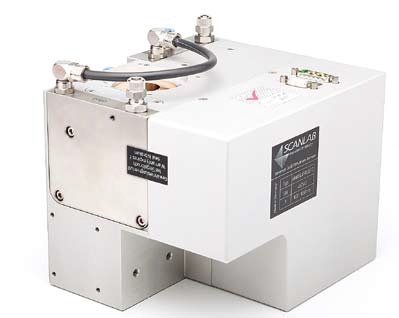
For numerous automotive industry applications –particularly in the electro-mobility segment – a substance-to-substance bond between different materials, example between copper and aluminium, is of interest as an alternative to mechanical joining.
Advantages include improved electrical conductivity, more homogenous heat transfer and higher mechanical strength. Fabrication of devices and fittings likewise often calls for pressure-tight bonding of the same or dissimilar material types; for instance in heat exchangers or cooling units. This is precisely where the new welDYNA 2D scan system from SCANLAB GmbH shines. Overlapping laser beam motions relative to the seam geometry enable tear-resistant welds of diverse materials, even for joining partners with poor weldability.
As an innovative manufacturer of OEM components for laser processing machines, SCANLAB has developed a scan system for oscillating-laser-beam cutting and welding.
The new welDYNA scan head unites the advantages of higher laser powers and maximum dynamics. Considerable process benefits are gained by welding and cutting with high-frequency beam oscillation, particularly in macro material processing of larger components. For example, thick metal sheets and fiber-reinforced plastics can be cut more quickly and cleanly. Diverse materials of poor weldability can be robustly bonded, too.
According to the company this technology already has proven merits for laser beam cutting too. High-dynamics beam oscillation allows much faster cutting speeds, along with improved cutting quality. Key factors are the high ‘wobble motion’ frequencies of several kHz and the availability of freely definable scan patterns. Together, they deliver far superior process parameters compared to other laser methods. Applications show considerably reduced splatter formation, making weld seams and cut edges clearly smoother while also slowing down optics wear.
In addition, SCANLAB said the new scan head is designed for multi-kW lasers of high beam quality and features digital servo control, an integrated sensor system for real-time monitoring, and water and air cooling in a robust, industrially-suitable housing. It can be easily integrated or installed with collimation and focusing modules of commercial fixed optics. Particularly in sectors such as aerospace or mechanical engineering and metal processing, where thick metal parts and composite materials must be cut, this new scan solution opens up countless interesting new application possibilities.
Laser welding
Laser welding via scan systems offers advantages such as: low distortion – locally limited energy input to workpieces leads to low thermal and mechanical loads; contactless – comfortably long working distances (up to approx. 1 m) offer considerable flexibility even when using industrial robots; and short process times – high weld speeds and real-time monitoring increase productivity.
These characteristics, coupled with high quality and extensive workpiece-geometry design freedom, have elevated scanner laser welding to a broadly-utilised joining process in modern industrial production. And it enables welding of diverse recyclable materials (e.g. plastics, metals and glass) in various thicknesses.
Laser cutting
As a wear-free cutting tool, lasers have quickly earned their place in industrial manufacturing. In conjunction with a scan system, they also offer compelling advantages such as high flexibility in shaping cutter contours, low setup costs and high process speeds (and hence shorter process times). Unlike traditional mechanical cutting methods, laser cutters can also process a wide range of materials – from films and paper all the way to glass and metals.
Cutting applications are mainly characterised by large fields, small spots, high throughput and on-the-fly processing. With label cutting (kiss cuts), contours are only cut into the upper material layer, without damaging underlying layers. The key requirements for package manufacturing (cartons) are design flexibility and high contour-precision to ensure mechanical functionality, followed by rapid processing of large quantities. In the manufacture of grinding discs, one major contactless-cutting advantage is that the cutting tool is wear-free.
Optimal flexibility means waste minimisation, free-form cutting and cost-effective manufacturing even with the smallest production runs.
For micro-cutting of metal, too, lasers become superior cutting tools when combined with scan systems. For instance, the low distortion of the process allows fabrication of ultra-fine parts such as time-piece pointers and gears.
Highsnobiety Sneakers













